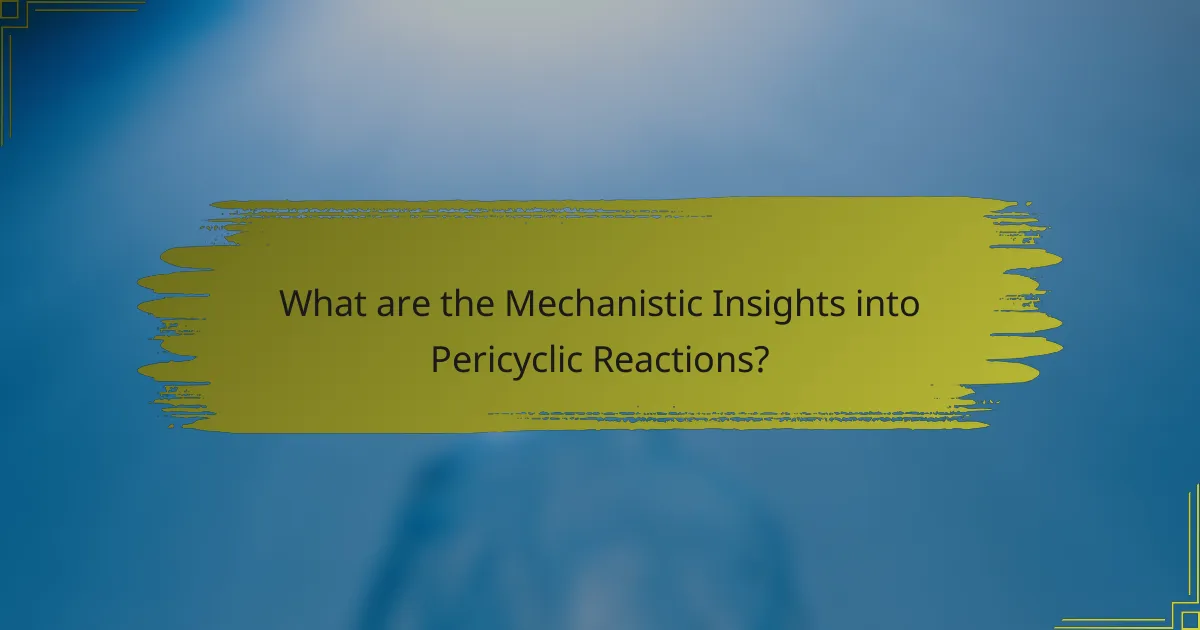
What are Pericyclic Reactions?
Pericyclic reactions are a class of chemical reactions that involve the concerted rearrangement of bonding electrons through a cyclic transition state. These reactions typically occur in a single step without intermediates, making them distinct from other reaction types. They are characterized by the simultaneous breaking and forming of bonds. Common examples include cycloadditions, electrocyclic reactions, and sigmatropic rearrangements. Pericyclic reactions follow specific selection rules, such as the Woodward-Hoffmann rules, which predict the allowed and forbidden pathways. These reactions are significant in organic synthesis and materials science due to their efficiency and stereochemical control.
How do Pericyclic Reactions differ from other reaction types?
Pericyclic reactions differ from other reaction types by involving concerted mechanisms. These mechanisms occur without intermediates, allowing simultaneous bond formation and breaking. This characteristic distinguishes them from typical stepwise reactions, which involve distinct intermediates. Pericyclic reactions are often driven by orbital symmetry considerations, as described by Woodward-Hoffmann rules. These rules predict the allowed and forbidden transitions based on the symmetry of molecular orbitals. In contrast, many other reactions do not rely on such symmetry principles. The concerted nature of pericyclic reactions results in specific stereochemical outcomes. This is unlike other reactions, which may lead to a mixture of products due to intermediates.
What are the defining characteristics of Pericyclic Reactions?
Pericyclic reactions are characterized by a concerted mechanism involving the simultaneous breaking and forming of bonds. These reactions typically occur in a cyclic transition state. They are stereospecific, meaning that the stereochemistry of the reactants determines the stereochemistry of the products. Pericyclic reactions can be classified into several types, including cycloadditions, sigmatropic rearrangements, and electrocyclic reactions.
The reaction mechanism is driven by the overlap of molecular orbitals. This overlap allows for the conservation of orbital symmetry, which is crucial for the reaction to proceed. Pericyclic reactions are generally facilitated by thermal or photochemical conditions. The Woodward-Hoffmann rules provide a framework for predicting the outcomes of these reactions based on symmetry considerations.
These characteristics make pericyclic reactions essential in synthetic organic chemistry. They often lead to the formation of complex structures with high efficiency and selectivity.
Why are Pericyclic Reactions significant in organic chemistry?
Pericyclic reactions are significant in organic chemistry because they provide a unique mechanism for molecular transformations. These reactions involve concerted processes, where bonds are broken and formed simultaneously. This results in high stereospecificity and regioselectivity, making them valuable in synthetic applications.
For instance, cycloadditions, a type of pericyclic reaction, can create complex cyclic structures efficiently. Additionally, pericyclic reactions often occur under mild conditions, reducing the need for harsh reagents. Their relevance is highlighted in natural product synthesis and materials science.
Research has shown that pericyclic reactions can be predicted using the Woodward-Hoffmann rules, which are based on molecular orbital theory. This predictive capability enhances their utility in designing new chemical reactions. Overall, their efficiency, selectivity, and predictability make pericyclic reactions essential in advancing organic chemistry.
What are the various types of Pericyclic Reactions?
Pericyclic reactions are chemical reactions that occur through concerted processes involving cyclic transition states. The main types of pericyclic reactions include cycloadditions, sigmatropic rearrangements, and electrocyclic reactions. Cycloadditions involve the formation of a cyclic product from two or more reactants. Sigmatropic rearrangements involve the migration of a sigma bond along with a π system. Electrocyclic reactions involve the conversion of a conjugated system into a cyclic product through the breaking and forming of bonds. Each type of pericyclic reaction follows specific selection rules, such as the Woodward-Hoffmann rules, which predict the allowed and forbidden pathways based on the symmetry properties of the molecular orbitals involved.
What are Cycloadditions and how do they function?
Cycloadditions are a type of pericyclic reaction where two or more unsaturated molecules combine to form a cyclic product. This reaction typically involves the formation of a new sigma bond while breaking pi bonds. Cycloadditions can occur through concerted mechanisms, meaning that bond formation and bond breaking happen simultaneously.
The Diels-Alder reaction is a well-known example of a cycloaddition, where a diene reacts with a dienophile to form a six-membered ring. Cycloadditions are stereospecific, preserving the stereochemistry of the reactants in the product. They are widely used in organic synthesis to create complex cyclic structures efficiently.
Research shows that cycloadditions can be facilitated by heat or light, influencing the reaction pathway. The transition state of a cycloaddition is typically cyclic and can be analyzed using computational chemistry methods. Overall, cycloadditions play a crucial role in the development of new materials and pharmaceuticals.
What are Sigmatropic rearrangements and their mechanisms?
Sigmatropic rearrangements are a class of pericyclic reactions involving the migration of a sigma bond along with a rearrangement of the molecular framework. These reactions typically occur in a concerted manner, meaning that bond breaking and forming happen simultaneously without intermediates. The mechanisms of sigmatropic rearrangements are categorized into different types based on the number of atoms involved in the rearrangement. The most common types include [1,3]- and [1,5]-sigmatropic rearrangements.
In a [1,3]-sigmatropic rearrangement, a sigma bond shifts from one atom to another across a three-atom system. In a [1,5]-sigmatropic rearrangement, the shift occurs across a five-atom system. The transition states for these reactions are cyclic and involve the formation of new bonds while breaking existing ones. The reactions are often facilitated by thermal conditions or light, which provide the necessary energy to overcome activation barriers.
The Woodward-Hoffmann rules help predict the stereochemical outcomes of these rearrangements based on orbital symmetry considerations. Experimental studies, such as those by Woodward and Hoffmann in 1965, provide substantial evidence for the concerted nature of these reactions.
What are Electrocyclic reactions and their characteristics?
Electrocyclic reactions are a type of pericyclic reaction characterized by the concerted reorganization of sigma and pi bonds. They involve the conversion of a conjugated system to a cyclic structure. These reactions can occur in either a thermal or photochemical context. The stereochemistry of the product is determined by the conditions under which the reaction occurs. In thermal reactions, the electrocyclic process typically follows the rules of orbital symmetry, as described by Woodward-Hoffmann rules. The reaction can be reversible, allowing for the formation of starting materials under specific conditions. Common examples include the thermal ring closure of 1,3-hexadiene to cyclohexene. Electrocyclic reactions play a significant role in synthetic organic chemistry and materials science.

What are the Mechanistic Insights into Pericyclic Reactions?
Pericyclic reactions are a class of organic reactions characterized by the concerted rearrangement of bonding electrons. They occur through cyclic transition states and involve the simultaneous breaking and forming of bonds. These reactions include cycloadditions, sigmatropic rearrangements, and electrocyclic reactions.
Mechanistic insights into pericyclic reactions are often explained using the Woodward-Hoffmann rules. These rules predict the allowed and forbidden reactions based on molecular orbital theory. The reactions are typically classified as either thermally allowed or photochemically allowed.
For example, the Diels-Alder reaction is a well-known cycloaddition that is thermally allowed. It involves a diene and a dienophile forming a six-membered ring. The transition state of pericyclic reactions can be analyzed using computational methods to understand the energy profiles and reaction pathways.
Research has shown that the stereochemistry of pericyclic reactions can be influenced by substituents on the reactants. This indicates that electronic effects play a significant role in the reaction’s mechanism. Overall, pericyclic reactions are essential for synthetic organic chemistry due to their efficiency and selectivity.
How do molecular orbitals influence Pericyclic Reactions?
Molecular orbitals significantly influence pericyclic reactions by determining the overlap of electron clouds during the reaction process. The symmetry of molecular orbitals governs the allowed transitions between reactants and products. For instance, the conservation of orbital symmetry is crucial for the feasibility of these reactions.
Pericyclic reactions can be classified into cycloadditions, sigmatropic rearrangements, and electrocyclic reactions, all of which depend on the symmetry of the involved molecular orbitals. The Woodward-Hoffmann rules illustrate how the symmetry properties of the molecular orbitals dictate whether a reaction is allowed or forbidden.
Experimental evidence supports this, as reactions that follow the symmetry rules proceed with high yield, while those that do not often fail to occur. Additionally, computational studies using molecular orbital theory provide insights into the electronic structure and energy barriers of these reactions. This highlights the critical role of molecular orbitals in predicting and understanding the outcomes of pericyclic reactions.
What is the role of symmetry in Pericyclic Reactions?
Symmetry plays a crucial role in pericyclic reactions by determining the feasibility and selectivity of these processes. In pericyclic reactions, the symmetry of the molecular orbitals involved dictates whether the reaction can occur through a concerted mechanism. This is often evaluated using the Woodward-Hoffmann rules, which relate the symmetry properties of the reactants to the allowed or forbidden nature of the reaction.
For example, reactions that maintain orbital symmetry during the transition state are favored. This means that if the symmetry of the highest occupied molecular orbital (HOMO) and the lowest unoccupied molecular orbital (LUMO) align properly, a pericyclic reaction is likely to proceed. Conversely, if the symmetry is disrupted, the reaction may be disallowed.
Experimental evidence supports this, as many successful pericyclic reactions exhibit clear symmetry in their transition states. Overall, symmetry considerations are essential for predicting the outcomes of pericyclic reactions and understanding their mechanisms.
How do orbital interactions affect reaction outcomes?
Orbital interactions significantly influence reaction outcomes by determining the pathways and products of chemical reactions. In pericyclic reactions, these interactions involve the overlap of molecular orbitals during the transition state. This overlap facilitates the formation or breaking of bonds, impacting the stability and reactivity of intermediates. For example, the symmetry of the orbitals can dictate whether a reaction is allowed or forbidden under the Woodward-Hoffmann rules. Additionally, the type of orbital interactions, such as π-π or σ-σ interactions, can lead to different stereochemical outcomes. Studies show that reactions with favorable orbital interactions yield products more efficiently, demonstrating their critical role in mechanistic pathways.
What factors influence the regioselectivity and stereoselectivity of Pericyclic Reactions?
Regioselectivity and stereoselectivity in pericyclic reactions are influenced by factors such as orbital symmetry, reaction conditions, and electronic effects. Orbital symmetry plays a crucial role in determining the allowed pathways for the reaction. The Woodward-Hoffmann rules provide guidance on predicting these pathways based on the symmetry of molecular orbitals. Reaction conditions, including temperature and solvent, can also affect the selectivity by stabilizing certain transition states over others. Additionally, electronic effects, such as the presence of electron-donating or electron-withdrawing groups, can influence the distribution of products by altering the stability of intermediates. These factors collectively dictate the outcome of pericyclic reactions, leading to specific regio- and stereochemical products.
What is the importance of substituents in determining reaction pathways?
Substituents are crucial in determining reaction pathways in organic chemistry. They influence the stability and reactivity of intermediates. For example, electron-donating groups can enhance nucleophilicity. This can lead to different reaction mechanisms. Conversely, electron-withdrawing groups may stabilize positive charges. This stabilization can direct the reaction to alternative pathways. The presence of substituents can also affect sterics, influencing transition state formation. Specific substituents can thus dictate whether a reaction proceeds via a concerted or stepwise mechanism. Overall, substituents play a vital role in shaping the outcomes of chemical reactions.
How does temperature affect the mechanisms of Pericyclic Reactions?
Temperature significantly influences the mechanisms of pericyclic reactions. Higher temperatures generally favor thermal pericyclic reactions, enhancing the reaction rate. Increased temperature can provide the necessary energy to overcome activation barriers. Conversely, lower temperatures may stabilize certain transition states, affecting reaction pathways. For example, some reactions may switch from a concerted mechanism to a stepwise mechanism at different temperatures. This temperature dependence is crucial in controlling product distribution and selectivity. Studies have shown that specific temperature ranges can lead to different stereochemical outcomes in pericyclic reactions. Therefore, temperature is a critical factor in determining the efficiency and selectivity of these reactions.

What are the Applications of Pericyclic Reactions in Various Fields?
Pericyclic reactions have applications in various fields such as organic synthesis, materials science, and pharmaceuticals. In organic synthesis, these reactions facilitate the formation of complex molecules efficiently. They enable the construction of cyclic compounds and stereochemistry control. In materials science, pericyclic reactions contribute to developing polymers and functional materials. They are used to create light-emitting devices and solar cells. In pharmaceuticals, these reactions are crucial for synthesizing drug candidates and active pharmaceutical ingredients. Their ability to form multiple bonds in a single step is particularly valuable. Overall, pericyclic reactions play a significant role in advancing various scientific domains.
How are Pericyclic Reactions utilized in synthetic organic chemistry?
Pericyclic reactions are utilized in synthetic organic chemistry for their ability to form complex structures efficiently. These reactions involve concerted mechanisms that allow for the simultaneous breaking and forming of bonds. They are crucial for synthesizing natural products and pharmaceuticals.
For example, cycloadditions can create cyclic compounds in a single step. This reduces the number of synthetic steps required. Furthermore, pericyclic reactions are stereospecific, leading to products with defined stereochemistry.
The Diels-Alder reaction is a well-known example, allowing the formation of six-membered rings. This reaction is widely used in the synthesis of terpenes and steroids. The efficiency of pericyclic reactions often results in higher yields and reduced waste.
Studies show that they can be performed under mild conditions, making them environmentally friendly. Overall, pericyclic reactions are integral to modern synthetic strategies in organic chemistry.
What role do Pericyclic Reactions play in the synthesis of natural products?
Pericyclic reactions are crucial in the synthesis of natural products. They facilitate the formation of complex molecular structures through concerted mechanisms. These reactions include cycloadditions, sigmatropic rearrangements, and electrocyclic processes. They often occur under mild conditions, making them advantageous for synthesizing sensitive natural compounds.
For example, the Diels-Alder reaction, a type of cycloaddition, is widely used to construct six-membered rings in natural product synthesis. Pericyclic reactions can also enhance stereoselectivity and regioselectivity in product formation. This precision is essential for achieving the desired biological activity in natural products.
Research has shown that pericyclic reactions can lead to the efficient synthesis of alkaloids and terpenes, which are significant classes of natural products. Their ability to create multiple bonds and rings in a single step contributes to the overall efficiency of synthetic routes. Thus, pericyclic reactions play a fundamental role in developing new natural products with potential therapeutic applications.
How do Pericyclic Reactions contribute to drug development?
Pericyclic reactions play a significant role in drug development by enabling the synthesis of complex organic molecules. These reactions allow for the formation of multiple bonds in a single step, which can streamline the drug synthesis process. They are characterized by their concerted mechanisms, meaning that bond-making and bond-breaking occur simultaneously. This feature leads to high selectivity and efficiency in the formation of desired products.
For example, cycloadditions, a type of pericyclic reaction, are often utilized to create cyclic structures found in many pharmaceuticals. Additionally, these reactions can facilitate the modification of existing drug compounds to enhance their efficacy or reduce side effects. The ability to create diverse molecular architectures rapidly is crucial in medicinal chemistry.
Research has shown that pericyclic reactions can lead to the development of new drug candidates with improved biological activity. A study published in “Chemical Reviews” by D. J. Cram and colleagues highlights the importance of these reactions in the synthesis of natural products and pharmaceuticals. This underscores the value of pericyclic reactions in advancing drug discovery and development.
What are some industrial applications of Pericyclic Reactions?
Pericyclic reactions have several industrial applications, particularly in the synthesis of pharmaceuticals and agrochemicals. These reactions facilitate the formation of complex organic molecules efficiently. For instance, Diels-Alder reactions are widely used to create cyclic compounds that serve as intermediates in drug manufacturing.
Another application is in the production of polymers. Pericyclic reactions contribute to the development of high-performance materials through polymerization processes. Additionally, they are utilized in the synthesis of natural products, which are crucial for various industries, including food and cosmetics.
The efficiency and selectivity of pericyclic reactions make them valuable in industrial settings. Their ability to proceed under mild conditions reduces energy consumption, aligning with sustainable practices in chemical manufacturing.
How are Pericyclic Reactions applied in materials science?
Pericyclic reactions are applied in materials science for the synthesis of advanced materials. These reactions facilitate the formation of complex molecular structures. They are particularly useful in creating polymers and organic materials with specific properties. For instance, cycloadditions can produce polymers with enhanced thermal stability. Diels-Alder reactions are commonly used to create conjugated systems in organic photovoltaics. These systems improve energy conversion efficiencies in solar cells. Additionally, pericyclic reactions enable the design of functionalized materials for drug delivery applications. Their ability to generate diverse molecular architectures is crucial in developing innovative materials.
What is the significance of Pericyclic Reactions in polymer chemistry?
Pericyclic reactions are significant in polymer chemistry due to their ability to facilitate the formation of complex polymer architectures. These reactions often occur under mild conditions, making them suitable for sensitive monomers. They allow for the creation of new chemical bonds through concerted mechanisms, which can enhance polymer stability and functionality. Examples include cycloadditions and sigmatropic rearrangements. These reactions contribute to the development of innovative materials with tailored properties. Their efficiency in generating cyclic structures is particularly valuable for creating ring-opening polymers. Overall, pericyclic reactions enable precise control over polymer synthesis and properties.
What best practices should be followed when studying Pericyclic Reactions?
When studying Pericyclic Reactions, it is essential to understand the underlying mechanisms. Focus on the Woodward-Hoffmann rules to predict reaction outcomes. Visualizing reaction pathways through molecular orbital theory enhances comprehension. Practice drawing potential energy surfaces to illustrate reaction coordinates. Utilize computational chemistry tools for detailed analysis of complex reactions. Review literature for case studies that highlight successful applications. Engage in group discussions to clarify concepts and share insights. Regularly solve practice problems to reinforce understanding of reaction types.
Pericyclic reactions are a class of chemical reactions characterized by the concerted rearrangement of bonding electrons through cyclic transition states, without intermediates. This article provides a comprehensive overview of the types of pericyclic reactions, including cycloadditions, sigmatropic rearrangements, and electrocyclic reactions, along with their defining characteristics and the significance of orbital symmetry in determining reaction pathways. Additionally, the article explores the applications of pericyclic reactions in organic synthesis, materials science, and pharmaceuticals, highlighting their efficiency and selectivity in creating complex molecular structures. Mechanistic insights, driven by the Woodward-Hoffmann rules, are also discussed to understand how these reactions can be predicted and utilized effectively in various fields.
